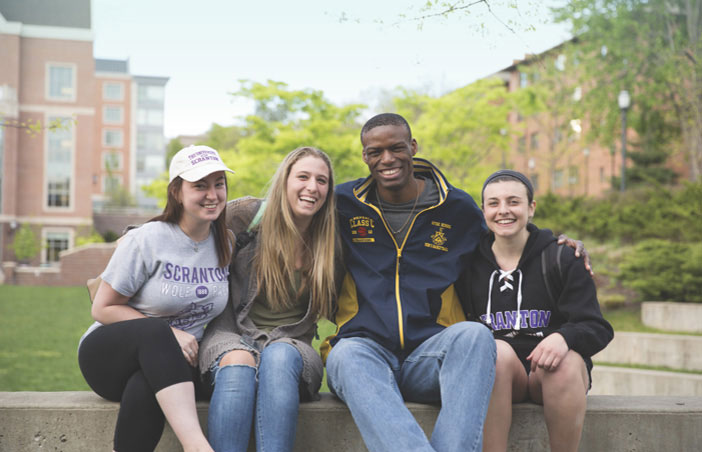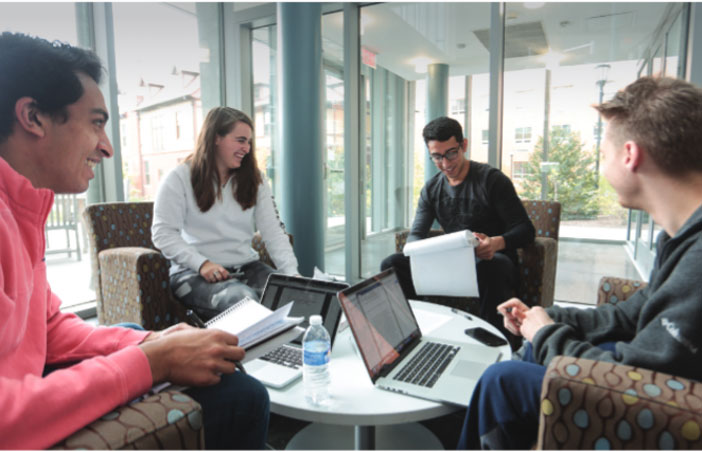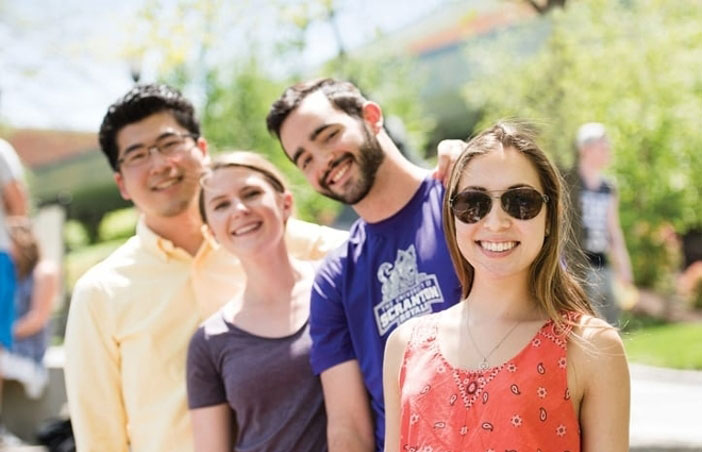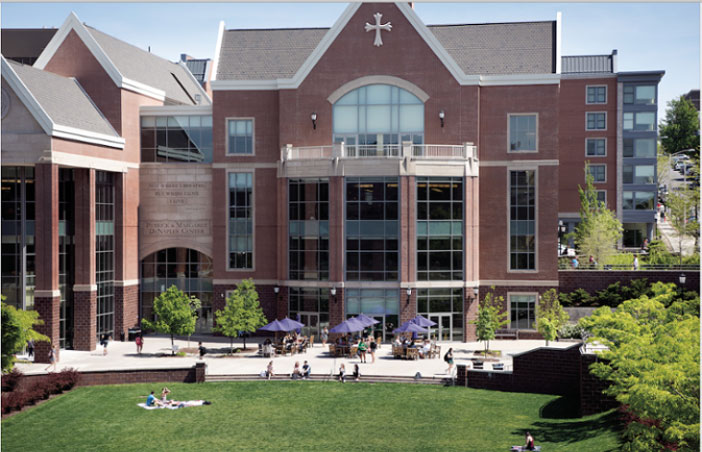Mathematics Department
What We Do:
Encourage students to channel their love of logic, understanding patterns, problem-solving, and master the language of science to make a difference in the world around them. Professors in the Mathematics Department won’t simply tell students an answer – they help students discover how to find one themselves. Our classrooms, Math Lab and Math Project Room are hubs for learning, discussion, invention, and creativity.
How We Stand Out:
- Interactive learning in the classroom.
- Opportunities for internships and faculty-mentored research prepare students for success in the competitive job market and/or advanced study in mathematics.
- State of the art Math Lab with high-tech computers where students use the latest versions of Maple, Lurch, GeoGebra, Overleaf and other math software.
- Small class sizes and student-oriented professors create a strong learning community.
- Broad course selection not offered at many other undergraduate institutions.
- Special Topics reader courses in response to individual student’s interest.
Programs:
The mathematics department offers a B.S. in Mathematics and a B.S. in Mathematical Sciences, with tracks in Actuarial Science, Biological Sciences, Computer & Information Science, Data Science, and Physical Sciences. These programs share a number of courses in the first and second year adding flexibility to deciding which path to pursue. To visualize the interconnectedness of the programs specific requirements, see specific degree requirements. Additionally, the department offers minors in Actuarial Science and Mathematics, and the Data Science Concentration is also affiliated with the Mathematics Department.
- Mathematics B.S. - The program provides students with both breadth and depth in the discipline of mathematics. It's a good choice for students looking towards a career directly tied to mathematics or pursuing graduate work. Our mathematics majors have great flexibility: many continue with advanced study in mathematics while others pursue a career in education, or any one of a variety of other fields, see Career Outcomes below.
- Mathematical Sciences B.S. - Student in this program choose from the following tracks: Actuarial Science, Biological Sciences, Computer & Information Science, Data Science, and Physical Sciences. All students take core courses in calculus and linear algebra, and then, depending on the chosen track, an array of upper-division mathematics courses and cognate courses from the partner discipline. Elective courses in mathematics, the partner discipline, and from the sciences at large are required and can be chosen in a manner that helps the student lay the groundwork for future graduate study, careers, or to take electives recommended for pre-med or pre-health professions students and is flexible enough to facilitate a double major with a program in the chosen partner discipline.
- Actuarial Science Minor - The Minor in Actuarial Science is designed to provide students with the fundamentals needed to pursue careers in the actuarial profession including coursework in the subject areas of two entry-level actuarial exams. The Minor requires 21 to 24 credits.
- Mathematics Minor - Mathematics Minor includes three semesters of calculus, Linear Algebra and two additional electives chosen from Mathematics courses numbered above 298 or a physics class, Applied and Engineering Mathematics.
- Data Science Concentration - Data science is an emerging, interdisciplinary field that uses scientific methods, processes, algorithms and systems to extract knowledge from data. The Data Science Concentration is designed to offer an opportunity for students, mainly in Applied Math and Applied Computing, to acquire data science knowledge and skills in addition to their major The Concentration requires 40 credits, of which 11 credits are of Math, 20 of Computer Science, and 9 of Data Science. Students in Applied Math and Applied Computing are able to complete the requirements as major courses, cognate course, and GE free electives.
Meet Our Faculty:
Discover professors who are passionate about their work in the Mathematics Department at The University of Scranton. Our faculty have a broad range of backgrounds, professional accolades and career experience. We come together to provide a well-rounded mathematics education for each and every student.
Just a few examples:
- Biomathematician Dr. Jason Graham draws connections between mathematical theory and other areas of science. He is currently working on mathematical representations of bone remodeling and injury response in articular cartilage.
- Dr. Kenneth Monks is a co-developer of Lurch, a word processor that can check your reasoning. A national award-winning coach of several math competition teams, he shares his love of problem solving, chaos and fractals, and mathematical proof theory in innovative ways to help students discover fun and joy in mathematics.
- Fr. John Levko, a Jesuit who specializes in differential geometry, holds a second doctorate in spirituality from the Pontifical Oriental Institute in Rome.
- Dr. Steven Dougherty and Dr. Maureen Carroll coauthored an article, “Tic-Tac-Toe on a Finite Plane,” based on the game of tic-tac-toe. In 2005, they were awarded the Mathematical Association of America’s Merten M. Hasse Prize.
Inside the Classroom:
- Small classes, averaging between 10-20 students, for a personalized learning experience.
- Strong foundations in calculus and linear algebra.
- High-tech computers and applications designed for math students.
- Unique classes like Topics in Biomathematics, The Art of Problem Solving, Chaos and Fractals, Coding Theory, and, and Mathematics for Social Justice.
Student Research:
Students who show an early interest in higher mathematics have the opportunity to enroll in our Faculty Student Research Program (FSRP) or Honors Program.
Through FSRP or the Honors Program, students are exposed to an array of academic opportunities. From joint research with faculty members to authoring professional papers and presenting at national conferences, undergraduate research often leads to scholarships and other benefits in graduate schools.
What types of projects do students work on with faculty?
-
In the 2022-23 academic year a student, Mia Gianello wrote a paper with Dr. Steven Dougherty titled "Distances in Graphs of Permutations" which will appear in the Rocky Mountain Journal. Mia is enrolling in medical school in the next semester.
-
Sara Myers authored a paper with Dr. Steven Dougherty titled "Orthogonality from Group Characters" which was published in the journal Involve in 2021. Sara is now studying in a graduate school in mathematics.
- Dr. Jason Graham mentored student presentations for a Mathematical Association of America meeting in 2014: A Mathematical Model of the Cardiovascular System by Joshua Jimenez, Mathematical Theory of Dynamic Task Allocation in Social Insects by Ivan Kent, and Mathematical Model of Mesenchymal Stem Cell Differentiation by Brittany Boribong.
- Francis George received a President’s Fellowship for Summer Research Award for 2014 for his research with Dr. Jakub Jasinski. This research explores locally contractive maps using Descriptive Set Theory techniques. Francis gave a talk on his research at the American Mathematical Society Annual Meeting.
- Samantha Baietti graduated from the Honors Program in 2009 having written the thesis Geometry of Solutions of a Differential Equation under the direction of Dr. Stacey Muir. Samantha gave a poster presentation of her work at the AMS and MAA Joint Mathematics Meetings.
- Nathan Carter, Class of 1999, coauthored Lurch, a mathematical word processor that checks your reasoning, with Dr. Kenneth Monks. Many other students of Dr. Monks have published research under his direction.
Career Outcomes:
Approximately 40 percent of our math majors pursue graduate degrees while 60 percent choose to enter the job market immediately following graduation. You’ll find Scranton graduates with a mathematics degree working in fields such as:
- Insurance
- Finance
- Computer Science
- Education
- Industrial Research Labs
- Statistical Data Institutions
- Transport & Logistics
- Public Administration
- Military Intelligence
- Business
- Medicine
- Law
To see examples of post-graduate education and careers that our graduates have undertaken click Mathematics Careers and Mathematical Sciences Careers.
Learn more about career options in math:







